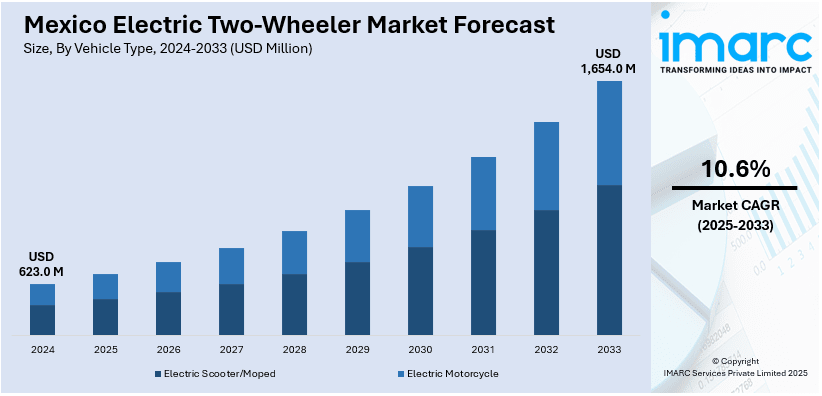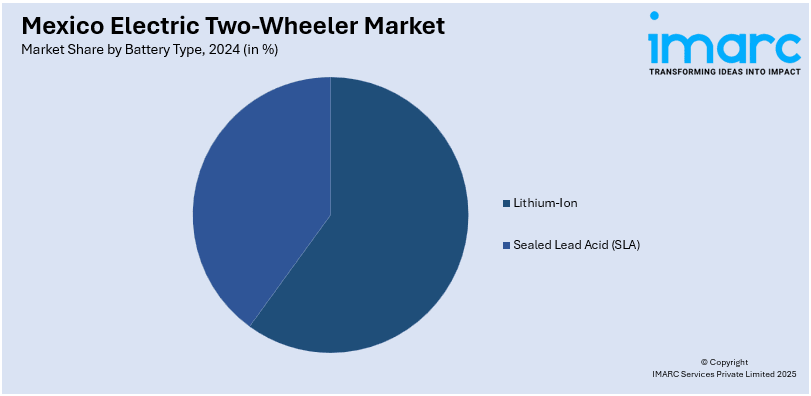
Mexico Electric Two-Wheeler Market Size, Share, Trends and Forecast by Vehicle Type, Battery Type, Voltage Type, Peak Power, Battery Technology, Motor Placement, and Region, 2025-2033
Mexico Electric Two-Wheeler Market Overview:
The Mexico electric two-wheeler market size reached USD 623.0 Million in 2024. Looking forward, IMARC Group expects the market to reach USD 1,654.0 Million by 2033, exhibiting a growth rate (CAGR) of 10.6% during 2025-2033. The market is driven by rising fuel costs, rapid urbanization, and government incentives promoting clean mobility. Growing environmental awareness, demand for affordable transportation, and expanding charging infrastructure further enhance adoption. Delivery services and younger consumers favor electric scooters for their cost efficiency and low maintenance, augmenting the Mexico electric two-wheeler market share.
|
Report Attribute
|
Key Statistics
|
|---|---|
|
Base Year
|
2024
|
|
Forecast Years
|
2025-2033
|
|
Historical Years
|
2019-2024
|
| Market Size in 2024 | USD 623.0 Million |
| Market Forecast in 2033 | USD 1,654.0 Million |
| Market Growth Rate 2025-2033 | 10.6% |
Mexico Electric Two-Wheeler Market Trends:
Rising Demand for Eco-Friendly Urban Mobility Solutions
The increasing demand for sustainable urban transportation is significantly supporting the Mexico electric two-wheeler market growth. With rising fuel prices and growing environmental concerns, consumers are shifting toward electric scooters and bikes as cost-effective and eco-friendly alternatives. Major cities such as Mexico City, Guadalajara, and Monterrey are witnessing traffic congestion and air pollution, prompting government incentives for electric vehicle (EV) adoption. Additionally, the younger population and delivery services are embracing electric two-wheelers for their affordability and low maintenance. Companies are expanding their electric vehicle portfolios, offering models with improved battery life and charging infrastructure. Mexico is experiencing significant growth, exporting USD 3.127 Billion to the United States in the first quarter of 2024. In 2023, the country manufactured upwards of 100,000 EVs, which projections expect to rise to over 300,000 units yearly by 2026. This growth is encouraged by significant industry players such as Tesla, General Motors, and Ford, alongside investments in lithium battery manufacturing and charging infrastructure. Moreover, Mexico has an established expertise in the manufacture of automobiles and strategic policies that serve as an opportunity for the electric two-wheeler market in North and Latin America. As urbanization accelerates and disposable incomes rise, the demand for convenient, emission-free mobility is rising, positioning electric two-wheelers as a key solution for Mexico’s transportation challenges.

Increase in Charging Infrastructure and Battery Swapping Stations
The rapid development of battery-swapping networks and charging infrastructure is creating a positive Mexico electric two-wheeler market outlook. To address range anxiety and enhance convenience, private and public players are investing in charging stations across urban and semi-urban areas. Mexico has 2,089 public electric vehicle (EV) charging stations and aims to deliver up to 38,000 more by 2041, in line with the projected growth of the electrified vehicle market from 43,000 to 700,000 units. This includes Evergo's investment of USD 400 Million to set up 15,000 charging points over ten years, ensuring the transition to EV cars. These trends create significant opportunities for Mexico's electric two-wheeler brand, capitalizing on increasing infrastructure and growing consumer demand. Besides this, startups are partnering with local businesses to deploy battery-swapping kiosks, allowing riders to exchange depleted batteries for fully charged ones in minutes. This innovation is particularly appealing to delivery and logistics companies that rely on continuous operation. Furthermore, the Mexican government is supporting EV adoption through subsidies and infrastructure projects, encouraging more consumers to switch from gasoline-powered vehicles. As battery technology improves and charging becomes more accessible, the electric two-wheeler market is poised for accelerated growth, making sustainable mobility more viable for a broader consumer base.
Mexico Electric Two-Wheeler Market Segmentation:
IMARC Group provides an analysis of the key trends in each segment of the market, along with forecasts at the country level for 2025-2033. Our report has categorized the market based on vehicle type, battery type, voltage type, peak power, battery technology, and motor placement.
Vehicle Type Insights:
- Electric Scooter/Moped
- Electric Motorcycle
The report has provided a detailed breakup and analysis of the market based on the vehicle type. This includes electric scooter/moped and electric motorcycle.
Battery Type Insights:

- Lithium-Ion
- Sealed Lead Acid (SLA)
A detailed breakup and analysis of the market based on the battery type have also been provided in the report. This includes lithium-ion and sealed lead acid (SLA).
Voltage Type Insights:
- <48V
- 48-60V
- 61-72V
- 73-96V
- >96V
The report has provided a detailed breakup and analysis of the market based on the voltage type. This includes <48V, 48-60V, 61-72V, 73-96V, and >96V.
Peak Power Insights:
- <3 kW
- 3-6 kW
- 7-10 kW
- >10 kW
A detailed breakup and analysis of the market based on the peak power have also been provided in the report. This includes <3 kW, 3-6 kW, 7-10 kW, and >10 kW.
Battery Technology Insights:
- Removable
- Non-Removable
The report has provided a detailed breakup and analysis of the market based on the battery technology. This includes removable and non-removable.
Motor Placement Insights:
- Hub Type
- Chassis Mounted
A detailed breakup and analysis of the market based on the motor placement have also been provided in the report. This includes hub type and chassis mounted.
Regional Insights:
- Northern Mexico
- Central Mexico
- Southern Mexico
- Others
The report has also provided a comprehensive analysis of all the major regional markets, which include Northern Mexico, Central Mexico, Southern Mexico, and others.
Competitive Landscape:
The market research report has also provided a comprehensive analysis of the competitive landscape. Competitive analysis such as market structure, key player positioning, top winning strategies, competitive dashboard, and company evaluation quadrant has been covered in the report. Also, detailed profiles of all major companies have been provided.
Mexico Electric Two-Wheeler Market News:
- September 28, 2024: Yadea unveiled its premium electric two-wheeler motorcycle, Kemper, at the 2024 SIMM Exhibition in Mexico City, along with the other top models, Keeness and Modern. With a top speed of 160 km/h, the motorcycle packs a punch aided by the latest technology (for example, a CATL battery which can be charged to 80 percent in 10 minutes). This launch reflects Yadea's commitment to advancing smart and eco-friendly transport. The company aims to revolutionize the electric two-wheeler market and promote green mobility in Mexico as it strengthens its presence through flagship stores and local partnerships.
Mexico Electric Two-Wheeler Market Report Coverage:
| Report Features | Details |
|---|---|
| Base Year of the Analysis | 2024 |
| Historical Period | 2019-2024 |
| Forecast Period | 2025-2033 |
| Units | Million USD |
| Scope of the Report |
Exploration of Historical Trends and Market Outlook, Industry Catalysts and Challenges, Segment-Wise Historical and Future Market Assessment:
|
| Vehicle Types Covered | Electric Scooter/Moped, Electric Motorcycle |
| Battery Types Covered | Lithium-Ion, Sealed Lead Acid (SLA) |
| Voltage Types Covered | <48V, 48-60V, 61-72V, 73-96V, >96V |
| Peak Powers Covered | <3 kW, 3-6 kW, 7-10 kW, >10 kW |
| Battery Technologies Covered | Removable, Non-Removable |
| Motor Placements Covered | Hub Typen, Chassis Mounted |
| Regions Covered | Northern Mexico, Central Mexico, Southern Mexico, Others |
| Customization Scope | 10% Free Customization |
| Post-Sale Analyst Support | 10-12 Weeks |
| Delivery Format | PDF and Excel through Email (We can also provide the editable version of the report in PPT/Word format on special request) |
Key Questions Answered in This Report:
- How has the Mexico electric two-wheeler market performed so far and how will it perform in the coming years?
- What is the breakup of the Mexico electric two-wheeler market on the basis of vehicle type?
- What is the breakup of the Mexico electric two-wheeler market on the basis of battery type?
- What is the breakup of the Mexico electric two-wheeler market on the basis of voltage type?
- What is the breakup of the Mexico electric two-wheeler market on the basis of peak power?
- What is the breakup of the Mexico electric two-wheeler market on the basis of battery technology?
- What is the breakup of the Mexico electric two-wheeler market on the basis of motor placement?
- What is the breakup of the Mexico electric two-wheeler market on the basis of region?
- What are the various stages in the value chain of the Mexico electric two-wheeler market?
- What are the key driving factors and challenges in the Mexico electric two-wheeler?
- What is the structure of the Mexico electric two-wheeler market and who are the key players?
- What is the degree of competition in the Mexico electric two-wheeler market?
Key Benefits for Stakeholders:
- IMARC’s industry report offers a comprehensive quantitative analysis of various market segments, historical and current market trends, market forecasts, and dynamics of the Mexico electric two-wheeler market from 2019-2033.
- The research report provides the latest information on the market drivers, challenges, and opportunities in the Mexico electric two-wheeler market.
- Porter's five forces analysis assist stakeholders in assessing the impact of new entrants, competitive rivalry, supplier power, buyer power, and the threat of substitution. It helps stakeholders to analyze the level of competition within the Mexico electric two-wheeler industry and its attractiveness.
- Competitive landscape allows stakeholders to understand their competitive environment and provides an insight into the current positions of key players in the market.
Need more help?
- Speak to our experienced analysts for insights on the current market scenarios.
- Include additional segments and countries to customize the report as per your requirement.
- Gain an unparalleled competitive advantage in your domain by understanding how to utilize the report and positively impacting your operations and revenue.
- For further assistance, please connect with our analysts.
 Request Customization
Request Customization
 Speak to an Analyst
Speak to an Analyst
 Request Brochure
Request Brochure
 Inquire Before Buying
Inquire Before Buying




.webp)




.webp)












